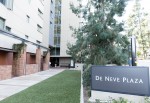Mi mamá proudly told my extended family members I was off to study at the famous UCLA while I silently wished I could stay home to study during my first year.
Coming to an institution that was not created for me, a bisexual first-generation Mexican American woman, forced me to learn lessons not typically found in the classroom. I should have left my hometown feeling like I was heading to another home even though my past generations have not been able to see an institution like UCLA as such.
But there are people ready to help out new students looking for their place. On the Hill, UCLA Residential Life offers ten different Living Learning Communities each with their own campus partnerships to help expand their events. These communities offer students a network of like-minded students, such as the Chican@/Latin@ and the Afrikan Diapora floors.
The experience can prove valuable for students looking to find their place on campus. For example, the Gender, Sexuality and Society community offers a Peertorship program for its residents sponsored by the LGBT Resource Center and Queer Alliance student group, in which students are paired with queer graduate students and queer alumni working professionals. All students, regardless of major and including transfers, can apply to live in these communities.
But many students, such as my freshman self, do not know these floors exist until they meet a friend living there. And as I’ve learned from these friends, these communities are struggling to fill their space, according to second-year political science student Eryka Tyler. And if they can’t recruit enough students to fill the entire floor, UCLA Housing fills the empty spaces with random students.
Not only is this a problem for the students who remain unaware of their opportunities, but including unaffiliated students can also dilute the floor’s focus on its mission.
Thus, Residential Life, which operates these floors, needs to perform more outreach, beyond a few brochures in the UCLA Housing office and the brief overview on their website, in order for these communities to be able to engage with as many willing students as possible.
Whatever the method, reaching out earlier and more aggressively will boost the number of applicants and create residents who are fully dedicated to the floor’s initiative. While a few Bruins actively check out the Residential Life website, click on the community overviews and decide to dedicate their year to living there, it’s a lot of effort for people to extend just to learn about the opportunities available to them. Most Bruins do not even hear about these communities until they see the names on their UCLA Housing application.
And while Residential Life is able to reach students during admit weekend through events like Black Admit Weekend and Raza Day, they must do more.
These communities can use a number of avenues to improve their outreach. Emails describing the different communities should be sent as soon as admission decisions are sent to prospective students, or tour guides could emphasize these communities on Bruin Day.
While it could help if resident assistants tried to encourage the randomly placed residents to partake in floor activities, these activities would have much better attendance if Residential Life did more to filter these communities beforehand to include people who actually want to live there. Residential Life should be receiving more applicants than they can accept into these communities, and they should work with the administration, specifically the undergraduate admissions office, to better promote the communities to prospective students in high school.
The home that students can find would easily justify the aggressive recruiting efforts required to fill the floors. Tyler lived on the Afrikan Diaspora floor in Reiber Hall last year. She said she actively searched for her home on campus and found out about the community while visiting UCLA during Black Admit Weekend. As a black woman in a predominantly white institution, Tyler was happy to find a place where she felt like she did not have to wear a shield at all times to protect her from racism and discrimination.
“I really enjoyed living on the floor because it was great to see the black community together, especially since you don’t really get to see your fellow black students on campus very often,” Tyler said.
Moreover, bringing together a group of students passionate about their ambitions not only helps them gain a meaningful college experience, but can offer the UCLA community a mutually beneficial relationship. For instance, the Design and Innovation floor could easily make it a collective goal to form a progressive plan for the university’s development.
The fact is that while Residential Life does make an effort at advertising these communities with brochures and a “Living Learning Community” tab on their website, the first time many Bruins see these communities is next to a checkbox on their UCLA Housing application. I bet many Bruins just learned that these communities exist by reading this article and wished they had known about it beforehand.
